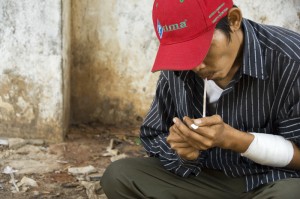NINE Cambodians were repatriated from Malaysia Thursday, with eight more arriving on Monday. Duped by unscrupulous human traffickers, they were beaten and forced to suffer months, sometimes years, of bonded labour on a Thai fishing vessel before a chance to jump ship presented itself. But the plight of trafficked men like these hardly ever gets a media mention. Why?
“Men don’t make as good TV,” said John McGeoghan of the International Organisation for Migration.
The repatriated men from nine provinces represent only a fraction of the Cambodians who have been lured onto Thai ships illegally, but their horrendous stories – out of sight from the general population – have not received the same limelight as Cambodia’s female flesh trade.
“They are the tip of the iceberg. People are not being told about trafficking onto Thai fishing fleets,” said Manfred Hornung, a monitoring consultant at Licadho.
Chhorn Khaov, 29, a former victim of male trafficking, has a story similar to the men who returned Thursday.
“My family was very poor. A broker told me I could earn a lot of money to support my family [working in Thailand],” he said.
McGeoghan said stories like these are common, and often Cambodian men are able to send money home. But he warned: “Without a contract, the employer has the power, so there is always a risk element.”
Once on the fishing boat, Chhorn Khaov was only given one or two hours of rest a day. The crew drugged him and the rest of the trafficked men to keep them awake and dependent of the boat’s drug supply.
“They forced us to use drugs so we would have the power to work,” he said.
But like the men who returned this week, Chhorn Khaov jumped ship in Malaysia, escaping the harsh conditions on the boat.
The common pattern, according to Hornung, is that men cross over the Thai border on foot at night with the help of a local broker. Once across, a Cambodian on the Thai side picks up the men and drives them to Pak Nam in Samat Prakarn province.
In Pak Nam, they are “locked up in guesthouses – from one day to one week – until they are handed over to a boat captain. Most people, once they’re locked up, they know they’re in trouble,” Hornung said.
Typically, the Thai fishing vessels trawl the South China Sea, according to Hornung, and the boats appear to avoid docking as much as possible.
“We’ve heard that the vessels are approached by bigger ships that take the catch and bring it to port. We’ve had cases of people who never saw land for almost three years,” Hornung said.
But few ships can remain at sea indefinitely. The 17 returning men escaped when their boats docked in Sarawak, Malaysia, at different times from different Thai boats, but all of them – afraid to contact local authorities – ended up on plantations, being exploited as illegal migrants.
A few of the men were able to contact their families in Cambodia, who then contacted Licadho. Working together with the Malaysian NGO Tenaganita, the International Organisation for Migration, the Ministry of Foreign Affairs and the Cambodian embassy in Malaysia, they were able to secure their return to Cambodia.
The complex repatriation process took months, but Hornung was pleased with the process and cooperation between the Cambodian and Malaysian governments.
Bith Kimhong, director of the Anti-human Trafficking Department at the Ministry of Interior, said: “Whenever we hear news of trafficking, we always help as quickly as we can. The two countries are cooperating in terms of anti-human trafficking.”
Though reliable statistics on the trafficking of men onto Thai fishing vessels do not exist, anecdotal evidence suggests the problem is serious and growing.
Vichuta Ly, at the Legal Support for Children and Women, said her organisation interviewed 193 migrant returnees from Thailand from 2007 to 2008, and of these people, nearly 40 percent had been trafficked onto Thai fishing vessels.
The National Project Coordinator at the United Nations Inter-Agency Project on Human Trafficking (UNIAP), Lim Tith, said he believes the global financial crisis could make Cambodian men more vulnerable to trafficking, as more may be forced to seek employment in Thailand as economic conditions worsen at home.
Terri Ly, executive director at the Healthcare Centre for Children (HCC), which runs one of the few male transit shelters in Cambodia, said the HCC had seven male clients from Thai fishing vessels in the last 10 months of 2007, but in the first 11 months of 2008, that number had jumped to 22 clients.
“Information from the Cambodian border police to HCC is that … the numbers of male Cambodians working in the Thai fishing industry is increasing,” Ly said.
There is no panacea for this situation, according to Hornung, but more information and attention will help.
“Migration is about seeking opportunities. It’s about information. Cambodians need to know about Pak Nam and the Thai fishing fleet. You’re less vulnerable the more information you have,” he said.
Published in the Phnom Penh Post

